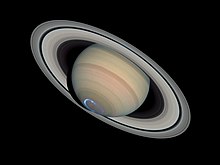
Back غلاف زحل المغناطيسي Arabic Magnetosfera de Saturn Catalan Magnetické pole Saturnu Czech Μαγνητόσφαιρα του Κρόνου Greek Magnétosphère de Saturne French शनि का चुंबकीय क्षेत्र Hindi Սատուրնի մագնիսոլորտ Armenian Magnetosfera di Saturno Italian Магнетосфера на Сатурн Macedonian Saturns magnetosfære NB
 Aurorae on the south pole of Saturn as viewed by Hubble | |
| Discovery | |
|---|---|
| Internal field[1][2] | |
| Radius of Saturn | 60,330 km |
| Equatorial field strength | 21 μT (0.21 G) |
| Dipole tilt | <0.5° |
| Rotation period | ? |
| Solar wind parameters[3] | |
| Speed | 400 km/s |
| IMF strength | 0.5 nT |
| Density | 0.1 cm−3 |
| Magnetospheric parameters[4][5][6] | |
| Type | Intrinsic |
| Bow shock distance | ~27 Rs |
| Magnetopause distance | ~22 Rs |
| Main ions | O+, H2O+, OH+, H3O+, HO2+ and O2+ and H+ |
| Plasma sources | Enceladus |
| Mass loading rate | ~100 kg/s |
| Maximum plasma density | 50–100 cm−3 |
| Aurora[7][8] | |
| Spectrum | radio, near-IR and UV |
| Total power | 0.5 TW |
| Radio emission frequencies | 10–1300 kHz |
The magnetosphere of Saturn is the cavity created in the flow of the solar wind by the planet's internally generated magnetic field. Discovered in 1979 by the Pioneer 11 spacecraft, Saturn's magnetosphere is the second largest of any planet in the Solar System after Jupiter. The magnetopause, the boundary between Saturn's magnetosphere and the solar wind, is located at a distance of about 20 Saturn radii from the planet's center, while its magnetotail stretches hundreds of Saturn radii behind it.
Saturn's magnetosphere is filled with plasmas originating from both the planet and its moons. The main source is the small moon Enceladus, which ejects as much as 1,000 kg/s of water vapor from the geysers on its south pole, a portion of which is ionized and forced to co-rotate with the Saturn's magnetic field. This loads the field with as much as 100 kg of water group ions per second. This plasma gradually moves out from the inner magnetosphere via the interchange instability mechanism and then escapes through the magnetotail.
The interaction between Saturn's magnetosphere and the solar wind generates bright oval aurorae around the planet's poles observed in visible, infrared and ultraviolet light. The aurorae are related to the powerful saturnian kilometric radiation (SKR), which spans the frequency interval between 100 kHz to 1300 kHz and was once thought to modulate with a period equal to the planet's rotation. However, later measurements showed that the periodicity of the SKR's modulation varies by as much as 1%, and so probably does not exactly coincide with Saturn's true rotational period, which as of 2010 remains unknown. Inside the magnetosphere there are radiation belts, which house particles with energy as high as tens of megaelectronvolts. The energetic particles have significant influence on the surfaces of inner icy moons of Saturn.
In 1980–1981 the magnetosphere of Saturn was studied by the Voyager spacecraft. Up until September 2017 it was a subject of ongoing investigation by Cassini mission, which arrived in 2004 and spent over 13 years observing the planet.
- ^ Cite error: The named reference
Russell1993-694was invoked but never defined (see the help page). - ^ Cite error: The named reference
Belenkaya1145was invoked but never defined (see the help page). - ^ Cite error: The named reference
Blanc238was invoked but never defined (see the help page). - ^ Cite error: The named reference
Sittlerwas invoked but never defined (see the help page). - ^ Cite error: The named reference
Tokarwas invoked but never defined (see the help page). - ^ Cite error: The named reference
Gombosi206was invoked but never defined (see the help page). - ^ Cite error: The named reference
Zarka378was invoked but never defined (see the help page). - ^ Cite error: The named reference
Bhardwaj328was invoked but never defined (see the help page).
© MMXXIII Rich X Search. We shall prevail. All rights reserved. Rich X Search